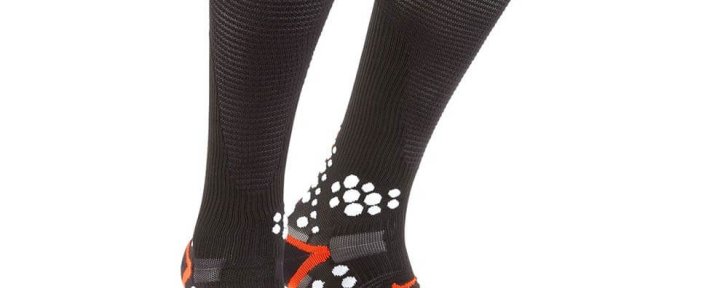Compression sleeves in running: Why use them?
Par LaurentPublié le 22/08/2019 à 21h06 — modifié le 22/08/2023 à 21h06 Temps de lecture : 3 minutes

Compression sleeves are part of these technical textiles that are now available to amateur runners. And we see a plethora of them on races for the general public, including me. Compression is a rapidly expanding field today where the leaders of the genre, BV Sport, Compressport and Sigvaris, now share a big cake. But there is now a plethora of brands of compression sleeves! Now sold in large sports surfaces, worn by professional athletes, these products play their role in sports performance.
But do we really know the real advantages of compression sleeves and other recovery socks? Partly for many of us, that's why I was interested. So I suggest you go further in understanding these accessories of the modern runner that are supposed to improve our training.
The theory of compression sleeves
Manufacturers are familiar with the aspects of Running Business, which is difficult to understand when researching compression sleeves. Here is a selection of the assets that the various market players highlight:
Reinforcement of venous return
Reduction of toxin accumulation
Improved recovery
Reduction of symptoms of pain during exercise and muscle fatigue
Improved endurance and prolonged effort
Improvement of the tonicity of the most stressed muscles during exercise
Reduced vibration and improved muscle performance
Toxin removal
Improvement of muscle, tendon and ligament oxygenation
Reduced tossing of calf muscle masses, often the cause of periostitis
The different types of compression sleeves
So much for all the nice benefits that the manufacturers of compression sleeves are praising us for. There are many players in this sector where growth has been very important in recent years. But do they ultimately propose the same thing? No. There are several types of compression sleeves. Compression can be progressive (advocated by BV Sport for example) or degressive (found in particular at Sigvaris). There are no studies that really prove which of these two methods is the most effective. I just wanted to point out that unlike a t-shirt, choosing a brand of compression sleeves changes the philosophy of the product. (As much as this difference has real impacts)
Okay for the theory. I have studied the subject, so I will give you in the following paragraphs the main points to know about compression sleeves.
Do compression sleeves improve sports performance?
One of the elements of our sporting performance is a good oxygenation of the muscles, oxygen being the number one fuel for endurance. Compression on the calf increases blood circulation in the muscle and deep veins. In other words, the increase in pressure in the veins in the calf accelerates the blood flow (the famous venous return so much praised!) to allow "fresh" oxygen to be brought more quickly into the muscle. This has the effect of making the aerobic process more efficient, so the fuel is oxygen.
From there to see an increase in performance... Either you are on a work around VO2Max and it is your ability to provide oxygen when you breathe that is limiting, or you are on an endurance effort and you do not need to provide more oxygen to the muscle....
Compression sleeves allow better recovery?
For me, the number one interest of this process is in the recovery process. Muscles, and the calf in particular, are sponges. Used" blood (filled with lactic acid, free radicals and CO2) may tend to stagnate in the muscle. The compression sleeve, like a compression stocking, improves muscle oxygenation, so the muscle is cleaned more quickly from the waste it produces.
It can therefore be interesting during the race if it is long (the muscle will be exhausted less quickly) and after the race (the muscle having "worked better", will take less time to recover from the effort made). This is one of the reasons why there are compression sleeves, for running, and recovery socks, to be used after the race. The goal is generally the same, but the pressure exerted is less, the volume of blood exchanges at rest being up to 20 times lower at rest.
We are talking about compression sleeves here, but for me the effects of recovery socks are even more important. You really feel the difference if you put on these socks quickly after a race. Recovery is improved and the pain of the next day is greatly reduced. For several years now, BV Sport Prorecup Elite recovery socks have been following me on each competition and it has become a reflex to put them on as soon as possible after the race (after the essential recovery jogging!).
Do compression sleeves have other interests?
We are going to talk here about specific cases. I'm one of those people who have problems with my calves. Ultrasound and doplairs have not detected any Lodge Syndrome, yet during training I regularly have to deal with the consequences of this syndrome. On very intense training sessions (speed, ribs, lactic anaerobic...) where recovery is long (several minutes), I feel the pressure increase in my calves until I have strong cramps in both calves, forcing the training to stop before I have even reached a severe fatigue. More generally, I regularly feel during my races that my calves are limiting. This pressure gradually increases to the cramps.
In this case, I did my own tests, I either don't have cramps or much later in the training with my restraint sleeves. So the effect is proven for me. I don't know what percentage of runners have this kind of problem... But for them I strongly recommend compression sleeves!
Compression sleeves useful but not miraculous
Are you looking for a miracle product that will help you improve your performance? Go on your way you will be disappointed. If, on the other hand, you recognize yourself in certain situations mentioned above and want to optimize your drive, you may like compression sleeves and recovery socks! In the end, they will remain gadgets for some and interesting for others, proof that we are talking about an optional product!







